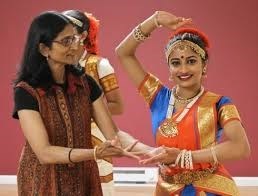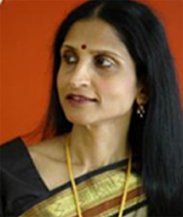WHO IS SUJATA NAIR MULLOTH?
Indian Classical Dancer, Bharata Natyam
COUNTY:
Lackawanna County
Sujata Nair Mulloth practices the art of Indian Classical Dance called Bharata Natyam. Bharatanatyam is an art of great antiquity, beauty, and dramatic potential. Bharatanatyam originated in the temples of South India more than 2000 years ago where it was performed as a part of the daily ritual of the temple. Stories from Indian mythology were retold through dance. The word “Bharata” is comprised of three syllables: Bha short for “Bhava” or emotion, Ra for “Raga” or melody, and Ta for “Tala” or rhythm. The word “Natyam” means dance. These three elements flow smoothly in this dance style.
The dance form has undergone several changes over the years, adapting to the social, religious, and political changes of the times. The prominent change, however, came in the 1930s when for the first time this art moved away from the temples and was brought out for the general masses to view. Now Bharatanatyam embraces music from various traditions of the world and incorporates stories from different cultures in the performances.
“My family was always interested in the arts. Going to performances as a young child sparked my interest in dance. I learned the art under the renowned Guru Dr. Saroja Vaidyanathan who founded the Ganesa Natyalaya in New Delhi India. This is a premier institution established nearly forty years ago.
I completed the traditional curriculum which included theory and practice in about six years. I then performed my debut solo recital which is a requirement of graduation. As is the tradition, this performance was attended by senior artists, dance critics, and judges who gave a detailed review/report of the show. This report gave me a standing among the performers and allowed me to transition into being a performing artist on my own. Since my debut, I have performed internationally for over thirty years. I have taught several generations of students in India, UK, and USA and choreographed several productions.”
Twenty-five years of performing has provided her with great insights. She learned the strengths and limitations of the style. Internationally, she also learned how people react to the performances in different cultures. She came to understand that, when performing before an uninitiated audience, the performance needs to be tailored to some degree according to their level of exposure to Indian Culture. Experimenting with the various different musical traditions of the world allowed her to see the dance form as a collection of movement and mime techniques that could be used to communicate concepts and emotions.
Sujata established the Kala School of Indian Dance in Clarks Summit PA, which follows the rigorous curriculum from India the Kala School. Branches of her school are in both Scranton PA and Binghamton NY. She also teaches the art form at the Wilkes University Conservatory. She imparts to her students an in-depth knowledge of the theory and practice of Bharata Natyam and its relation to the history and culture of India. Teaching the dance movements, the hand gestures, the facial expressions, and the meaning behind these, she passes down the knowledge of how to use these fundamentals in different combinations to tell a story.
“In India, the classical arts are not merely a form of entertainment but a part of the daily life of the people. Each hand gesture or movement has a cultural and historical significance. My graduate studies in world history, with an emphasis on Indian history, make me uniquely qualified to understand and appropriately convey the significance of the different aspects of dance that are rooted in Indian Culture and History. Thus, through the workshops, I could expose my students to a new style of dance, music, painting, and literature, deepening their interconnections and their links to Indian Philosophy and Culture.”
The Arts in India are deeply rooted in Yoga, Philosophy, and Culture. Therefore, there is a potential discussion that could emerge from any demonstration of Indian Dance. In a school setting, starting with dance, she can move into discussions on Indian history, art, religion, culinary arts, etc. Sujata works with teachers of different subjects like history, art, and more, to demonstrate how dance ties into each of these areas. By providing an Indian perspective in these different subject areas, the students could immerse themselves in the different aspects of India for the period of her residency at their school. This immersion gives children a greater appreciation for a civilization that has survived for thousands of years, and more detailed exposure to a culture and a way of life quite different from their own. She hopes to teach them that it is not only okay to be different, but it is also actually quite wonderful.
“Teaching children in the UK and the USA created a need to adopt a new approach in teaching. Abundant background information about the language, music, culture, and society of India had to be a part of the class to deepen their understanding. As the only Indian Classical Dance teacher in the area, I feel responsible to ensure that students are given a strong basis of the style and culture. The projects and presentations I have done in the libraries in the UK and in some of the school districts in the USA have been about India and its artistic traditions. These have focused on the interconnections between the arts and their connections to Indian philosophy and religion.
It is all this exposure and experience that I bring into my choreographies. Moving away from traditional spiritual themes, my thrust is to use the movement vocabulary of Bharata Natyam to depict unique and abstract concepts. Alternatively, I use non-Indian music to depict a typical traditional Indian theme or story. Thus I try to create work that is seen not merely as a different art form from a distant land but is enjoyed as something exotic that is rich in mime and movement.”
While Sujata’s family always had a love for the arts, she is the first performing artist in her family. She has been involved with Bharata Natyam all her life. Her daughter now also carries on the tradition with her. Sujata’s work, at this point in her career, focuses primarily on teaching the Bharata Natyam style of Indian classical dance, and on choreographing dances that reflect combined Indian/American identity.
“Although rooted in Bharata Natyam, my work incorporates influences from the western artistic environment. My work reflects an interface of the old (Bharata Natyam is a 2000-year-old, ancient dance) and the new (new influences, new compositions based on western classical music and new environment) where one challenges the other, each, in turn, provoking and sustaining.”
According to Sujata, the 2000-year-old art form currently faces the biggest challenge of its long history: Bharata Natyam now inhabits a new land with a very different cultural environment. She sees one way it can survive would be that the art will have to adapt to new sensibilities.
“When the ancient art is allowed to merge with diverse artistic elements, what emerges is a style defined by a new authenticity… one that can hold its own at home in India while also being embraced by new cultures. Choreographing dances that bridge the gap between Bharata Natyam and contemporary culture allows a better understanding of this exquisite dance and promotes interest in Indian culture.”
INTERVIEWS & PERFORMANCES
Sujata discusses the traditions and culture of Bharata Natyam on “Lackawanna County Arts & Culture Live”:
a Zoom Interview from June, 2020 (Sujata’s presentation begins at 1:04:10)


